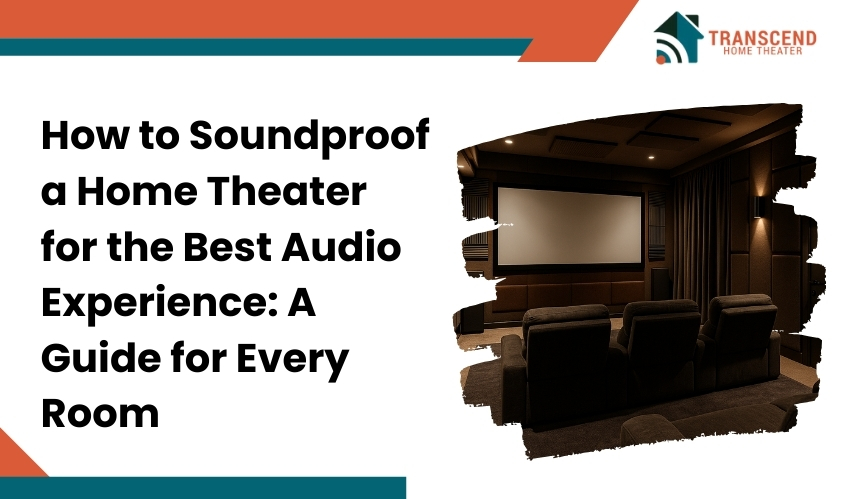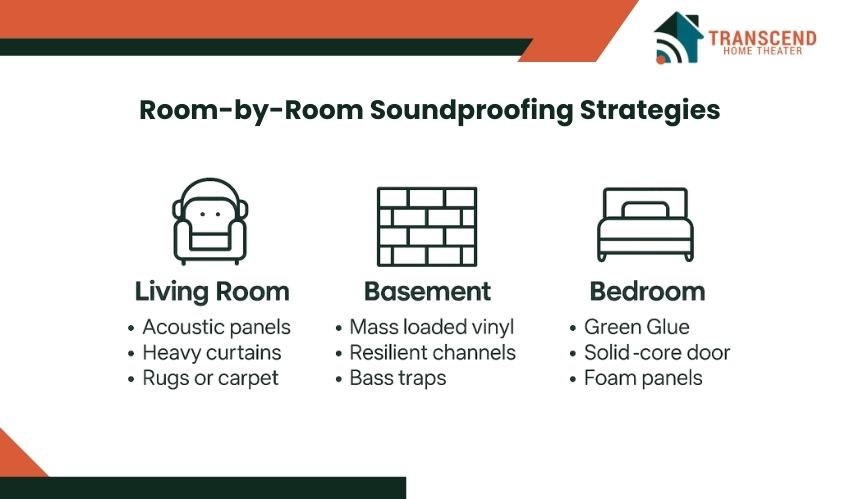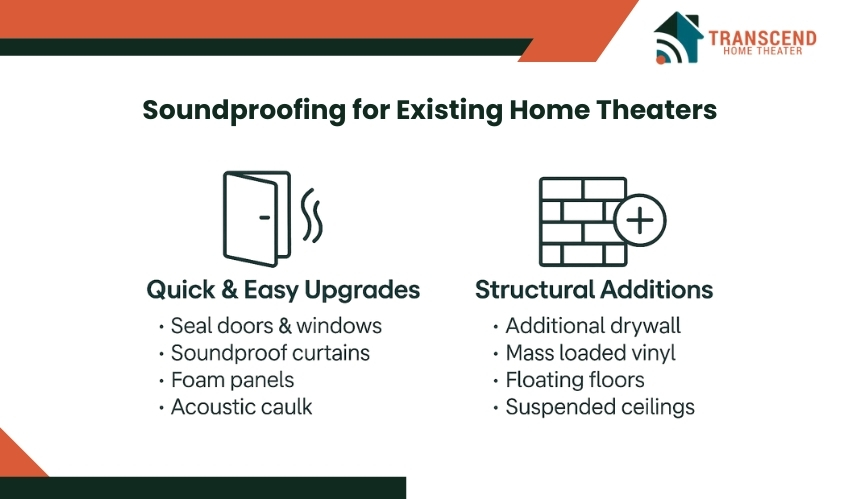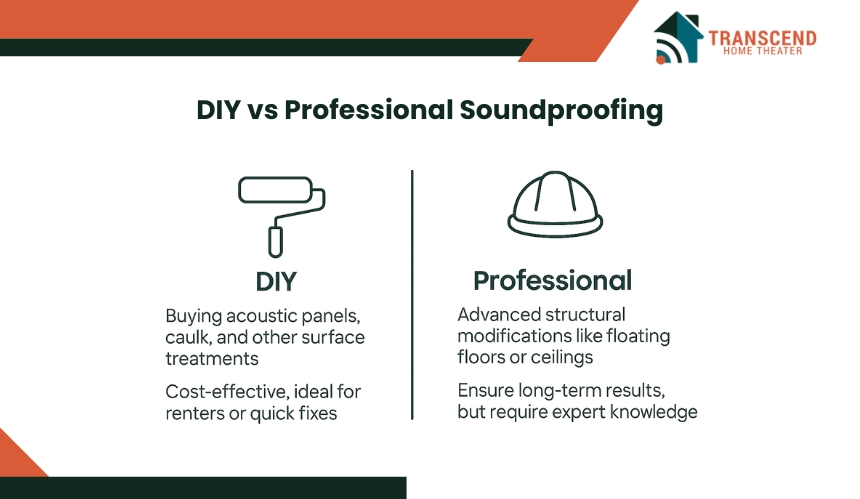How to Soundproof a Home Theater for the Best Audio Experience: A Guide for Every Room

Building a home theater is not just about a big screen and powerful speakers. The real difference comes from how sound travels inside the room and how much of it leaks out.
If your theater is not soundproofed, dialogue can feel muddy, bass may rattle the walls, and every loud scene can disturb the rest of the house.
Two of the quickest ways to improve your setup are installing acoustic panels to reduce echo and sealing gaps around doors and windows to block sound leaks. These simple fixes can instantly create a more immersive environment while keeping noise contained.
In this article, we’ll break down the fundamentals of soundproofing, explore the best materials and systems, and show you how to apply them room by room.
Understanding the Basics of Home Theater Soundproofing

Before diving into materials and room-specific strategies, it’s important to understand the fundamentals. Knowing how sound behaves inside and outside a room helps you choose the right solutions and avoid wasting money on fixes that don’t work.
What Does Soundproofing Really Mean?
Soundproofing is about controlling how sound moves between spaces. Unlike acoustic treatment, which improves sound inside the room, soundproofing focuses on blocking and containing noise. It prevents movie explosions from shaking the rest of the house while keeping outside disturbances like footsteps or traffic from interrupting your cinematic experience.
Why Soundproofing Your Home Theater Matters?
A home theater should feel like an escape, not a battle with unwanted noise. Without proper soundproofing, dialogue becomes unclear, bass frequencies leak into other rooms, and every sound effect loses its impact. Good sound isolation enhances clarity, balances low and high frequencies, and allows you to enjoy movies at the right volume without compromise.
Core Acoustic Concepts You Need to Know
- Reflection: Hard surfaces bounce sound, creating echoes that blur dialogue.
- Absorption: Soft or porous materials soak up sound waves, reducing reverb.
- Diffusion: Surfaces scatter sound evenly, preventing “dead spots” or overly bright areas.
- Transmission Loss: How much sound a wall, ceiling, or floor can block from passing through.
- Low-Frequency Challenges: Deep bass travels through walls and floors more easily, requiring specialized solutions.
Understanding these principles is the foundation for making the right soundproofing choices. Each strategy you use in later steps connects back to these core concepts. This includes sealing doors, adding insulation, or using advanced decoupling systems.
Types of Soundproofing Materials and Systems

Before applying soundproofing to any room, it helps to know the main materials and systems available. Each option works differently, so the right choice depends on your space, budget, and soundproofing goals. Six main types of soundproofing materials for home cinema are explained below:
1. Acoustic Foam Panels
Acoustic foam is lightweight and easy to install. These panels absorb mid and high frequencies, cutting down echo and reverberation. They are best for improving clarity in dialogue and reducing sharp reflections.
2. Mass Loaded Vinyl (MLV)
MLV is a dense and flexible sheet that blocks sound from traveling through walls, floors, and ceilings. It is effective for keeping noise inside your home theater and preventing outside disturbances from leaking in.
3. Green Glue
Green Glue is a sound-damping compound applied between two rigid layers, such as drywall or plywood. It converts sound energy into heat energy, lowering noise transfer between connected surfaces.
4. Cork Flooring
Cork is a natural sound-absorbing material. It works well for reducing floor vibrations and softening echoes. It also adds comfort underfoot, which makes it a practical flooring option for home theaters.
5. Resilient Channels
Resilient channels are metal strips installed on walls or ceilings before drywall is attached. They create a small gap between surfaces, which reduces direct vibration transfer. This makes them ideal for controlling low-frequency sound leaks.
6. Bass Traps
Bass traps are designed to absorb deep, low-frequency sounds. Placing them in the corners of the room prevents bass build-up and keeps sound balanced across all frequencies.
Choosing the Right Materials
When selecting soundproofing materials, consider cost, effectiveness, and how difficult the installation may be. A new construction project allows more flexibility with structural solutions. Retrofitting an existing room often requires surface treatments and targeted upgrades. Consulting with a home audio professional can help match the right method to your setup.
Room-by-Room Soundproofing Strategies

Every room comes with its own set of acoustic challenges. Size, construction, and layout all affect how sound behaves. Below are the common issues and the best solutions for different types of home theater spaces.
How to Soundproof a Living Room Theater?
Living rooms are usually open spaces connected to kitchens or hallways. Shared walls, large windows, and hard surfaces make them prone to sound leaks and echo.
Noise can easily escape into other areas, while outside sounds can disrupt the movie experience. Below are the solutions to overcome these challenges and soundproof a living room theater:
- Use acoustic panels on side walls to reduce reflections.
- Add heavy curtains or layered drapes over windows to block outside noise.
- Place area rugs or carpet underlay to absorb footsteps and soften floor vibrations.
- Seal gaps around doors and windows with weatherstripping for better isolation.
How to Soundproof a Basement or Dedicated Theater Room?
Basements and media rooms are popular for home theaters, but they often face structural issues. Concrete walls carry low-frequency vibrations, and ceilings may transmit sound to rooms above.
Without treatment, bass can rattle the space and disturb the rest of the house. The following methods work best for this type of setup:
- Install mass loaded vinyl (MLV) on walls and ceilings to block noise transfer.
- Use resilient channels during wall or ceiling construction to separate drywall from studs.
- Place bass traps in corners to control rumbling bass.
- Choose cork flooring or a padded underlay to reduce floor vibration and impact noise.
How to Soundproof a Bedroom or Small-Space Theater?
Bedrooms or smaller rooms have thinner walls and limited space for modifications. Noise leaks easily into adjoining rooms, and outside sounds can be distracting.
Space constraints also limit the use of bulky soundproofing systems. The strategies below are best suited for compact spaces:
- Apply Green Glue between drywall layers for added sound isolation without taking up space.
- Use cork or acoustic foam underlays beneath floors to minimize noise transfer.
- Seal the entry point with a solid-core door and soundproof weatherstripping.
- Install compact foam panels strategically to improve clarity without overcrowding the walls.
Soundproofing for Existing Home Theaters

Not every home theater is built with soundproofing in mind. Many setups are added after a room is already finished, which creates challenges since major structural changes are harder to make. In these cases, the goal is to minimize noise leaks and improve sound isolation without tearing down walls.
Challenges of Retrofitting Existing Rooms for Soundproofing
Existing rooms often have thin drywall, hollow-core doors, and unsealed windows. These weak points allow sound to travel easily, especially low-frequency vibrations.
Construction limits also mean that options like resilient channels or rebuilt walls are not always practical. Retrofitting requires smart upgrades that deliver results without major renovation. The solutions below are effective for soundproofing existing rooms:
Quick and Easy Upgrades to Soundproof Existing Rooms
These methods are affordable, simple to install, and perfect for anyone who wants fast improvements without major construction.
- Weatherstripping and acoustic caulking around doors, windows, and outlets to seal gaps.
- Door sweeps to close the space beneath doors and stop sound leaks at floor level.
- Soundproof curtains or layered drapes to block external noise and absorb echoes.
- Foam panels for easy installation on walls and ceilings to cut echo in small rooms.
- Decorative acoustic panels that reduce reflections while adding style to the space.
Structural Additions for Better Isolation of Existing Rooms
For stronger results, adding layers and mass to existing surfaces can significantly improve sound isolation.
- Adding drywall with Green Glue over existing walls to increase mass and reduce noise transfer.
- Mass loaded vinyl (MLV) layers behind drywall or under flooring for added sound blocking.
- Floating floor systems or carpet underlays to reduce impact noise without reconstruction.
- Drop ceilings with acoustic tiles to minimize sound transfer through overhead spaces.
Acoustic Treatments for Better Home Theater Sound Quality
Even after soundproofing your home cinema, the way sound behaves inside the room matters just as much. Reflections from walls, ceilings, and floors can blur dialogue, while bass often builds up in corners and overpowers other sounds.
Some spots may feel too loud while others stay too quiet. Acoustic treatments solve these problems by controlling reflections, absorbing unwanted noise, and balancing frequencies for a clear, immersive experience.
Absorptive Treatments for Clearer Dialogue
Absorptive panels are designed to soak up sound waves instead of reflecting them.
- Acoustic panels placed at reflection points stop echoes from bouncing back.
- Foam panels are useful for reducing mid and high frequencies in small spaces.
- Thick carpets or rugs add surface absorption on floors to reduce reverb.
Diffusion Treatments for Even Sound Distribution
Diffusion spreads sound waves evenly across a room, preventing “hot spots” or dead zones.
- Wooden diffusers scatter mid and high frequencies naturally.
- Grid-style or skyline diffusers ensure that every seat experiences balanced sound.
- Best placement is usually the rear wall or ceiling, where reflections can be disruptive.
Low-Frequency Control with Bass Traps
Deep bass is one of the hardest elements to manage. Without treatment, it lingers and vibrates, masking dialogue and details.
- Corner bass traps absorb low-frequency buildup where it is strongest.
- Thicker absorbers placed behind speakers can also help tame vibrations.
- Combining bass traps with diffusers creates a more natural, theater-like soundscape.
DIY vs Professional Soundproofing for Home Theaters

When setting up a home theater, deciding between DIY soundproofing and professional installation depends on budget, skill, and the level of isolation you need.
DIY-Friendly Options for Soundproofing Your Home Theater
If your main goal is to reduce minor noise leaks or improve clarity, DIY methods are often enough. Adding soundproof curtains, placing acoustic panels, sealing cracks with weatherstripping and caulk, or using foam panels can all be done without special tools. These upgrades are low-cost, easy to apply, and perfect for renters or anyone who wants quick results.
When to Choose Professionals for Soundproofing a Home Theater
Some solutions require advanced construction knowledge. Green Glue drywall layering, resilient channel installation, or designing floating floors and ceilings are best handled by experts.
Professional installation ensures the materials perform correctly and prevents costly mistakes. While it requires more investment, the results deliver long-term noise isolation and better home resale value.
Advanced Soundproofing Tips for Audiophiles and Enthusiasts
For those who want cinematic precision, advanced soundproofing goes beyond basic fixes.
- Floating Subfloors: By decoupling the flooring from the structure, vibrations from subwoofers stay contained within the room.
- HVAC Noise Control: Soundproofing isn’t complete if air vents carry noise. Using insulated ducting, vibration isolators, and quiet fans reduces mechanical hums.
- Smart Acoustic Systems: High-end theaters benefit from automated acoustic calibration. Systems with EQ presets can adjust sound balance depending on whether you are watching movies, listening to music, or gaming.
- Dedicated Isolation Booths: Some enthusiasts even create fully decoupled spaces inside existing rooms, creating studio-level silence.
These advanced methods are best suited for enthusiasts who want a professional cinema experience at home.
Common Soundproofing Mistakes to Avoid in Home Theaters
Soundproofing mistakes can waste money and leave results far below expectations.
- Confusing absorption with isolation: Foam panels only reduce echo inside the room. They do not block noise from leaving or entering.
- Neglecting weak points: Even a small gap under a door, an open vent, or an unsealed electrical outlet can allow significant noise leakage.
- Over-investing in one method: Using only one material, such as curtains or foam, won’t solve all acoustic problems. Effective soundproofing usually requires a combination of sealing, mass, and absorption.
- Skipping planning: Many people start with random fixes instead of analyzing the room’s main weak points. A clear plan ensures better results and lower costs.
Avoiding these mistakes ensures your time and money lead to a theater that sounds great without disturbing the rest of the home.
For a theater that delivers both stunning visuals and flawless acoustics, Transcend Home Theater offers expert home theater design and installation services. From soundproofing to full room design, every detail is crafted for a true cinematic experience at home.
Frequently Asked Questions (FAQs)
Soundproofing blocks sound from entering or leaving a room, while sound masking adds background noise to make unwanted sounds less noticeable. Sound masking is common in offices, but not a substitute for true soundproofing in home theaters.
Yes. Bookshelves, couches, and heavy furniture can help absorb and diffuse sound. While not a replacement for dedicated treatments, smart furniture placement reduces echo and balances sound in smaller spaces.
Cork, recycled cotton insulation, and natural fiber acoustic panels are sustainable options. They provide effective absorption while supporting environmentally conscious design.
Recessed lighting fixtures and uncovered can lights can leak sound through ceiling gaps. Using sealed housings or acoustic backer boxes prevents noise escape while maintaining the desired lighting effect.
Yes. Professionally soundproofed home theaters are seen as premium features in modern homes. They can increase appeal to buyers and potentially raise resale value, especially in competitive markets.
Wireless speakers reduce the need for cable holes in walls, which are common weak points for sound leaks. However, the room still requires proper soundproofing to contain low-frequency vibrations and external noise.
